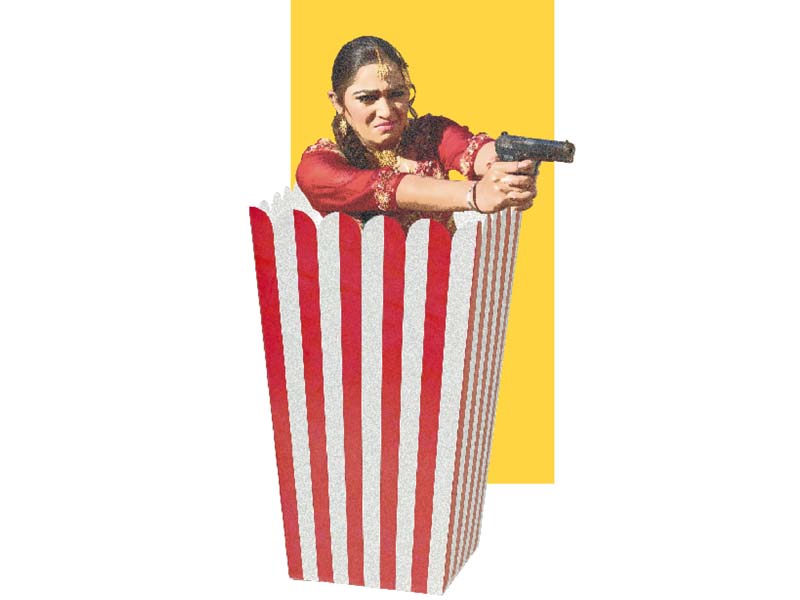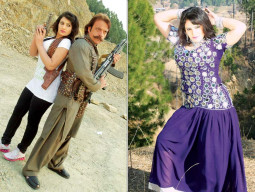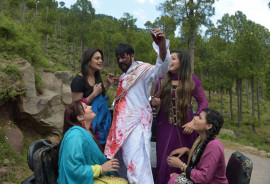
PESHAWAR:
Are weapons taking centre stage? Is there a man with blood in his eyes and a woman spilling out of her clothes? Chances it’s either a Pashto movie on TV or you googled ‘Pashto movie poster’ and a majority of the results feature three things: a man, a woman and a gun. And usually the first two are armed with the third, one with a glare and one with lust in the eyes – not hard to guess which sex dominates the plot.
Yes, it is a stereotype but a hard one to shake off when Pashto movie channels on cable, in cinemas and dramas sold on CDs have the motifs on replay. Some call it vulgarity, for some it’s a bit of fun but in the end – it glorifies a violence the region does not need. It objectifies a woman who already finds it challenging—and life threatening—to be seen as a complete entity, to have her voice heard.
The poor quality and high quantity of movies have presented a side of Pukhtun culture which is dissonant with the one which many Pukhtuns want to present to the world. Women are objectified and men own both the gun and the girl – a draw for the youth who do have not many avenues for entertainment.
Assembly-line production
The year 2015 saw 16 movies and countless CDs drama hit the market. Sex, drugs and booze are what sell. The term ‘arm candy’ here translates to a woman hungry for almost violent attention, gyrating around a man or men.
The fact that these films have a short-shelf life does not deter the producers and most of them only remain on for a few weeks.
A bit of self-fulfilment comes into play as in many of these flicks, man who stars, directs and produces, is the same. Talk to anyone in the industry and they will confirm while some of the men might be local, the women, attractive yet all from the same casting call come from the stage of Lahore.
In Jawargar or The Gambler, the hero is a gambler and, according to filmmakers, his purpose is to highlight the problem, the addiction, but the audience would be hard-pressed to see any subliminal or obvious public interest message.
Inside the darkly lit cinema, amid dankness and sweat, the audience sees the hero as someone they want to be. His swagger gets a standing ovation and the cinema hall fills with catcalls and wolf whistles appreciating the character.
The plot does more to serve the idea that women are merely there to serve a purpose defined by men. One of the gamblers bets his daughter. But if there is any point tailored to evoke moral outrage, it surely isn’t the sale of a woman. It is the insult to the hero’s honour when a fellow better yanks his shawl as a gesture of disrespect over unpaid debts. The scene is followed by violence and by women dancing to get their lover. Hardly a subtle message.
From Lahore to Peshawar
It could be argued that till the 1980s, Pashto movies were still loosely based on Pukhtun culture. But Punjabi movies broke records and drew audiences towards a crasser depiction of gender roles. The producers in Khyber-Pakhtunkhwa went where the audiences were and so evolved a Pashto cinema which stands today.
“There are directors who have made efforts to go towards a different plotline but with the more sensational Punjabi movies out there, it’s not even a close competition,” said Layeq Zada Layeq, writer and cultural critic. Even the costumes women are stuffed into are made in Lahore.
Suffering not suffragettes
“They have really reached a new nadir, the way women are portrayed on screen. If they are not stopped, they can sink further.”
Women in today’s Pashto cinema are more oppressed than ever before. The woman who is a dancer is not the empowered person who chose a career or chose what she wants to do with her body.
They are dancers whose character arc ends in a gyration or in a Kalashnikov’s bang. Layeq added, “I would say less than one per cent of the female cast is hired locally, most of them are imported because they want to do it for the money.”

With all male directors and illiterate producers, this characterisation of women is not surprising. Not a single woman is ever involved in writing the script, or in the intelligent evolution of any movie.
Not a single movie has been produced, directed or written by a woman. Hypothetically speaking, if given the chance, women would write out the nudity, the lust-driven plot and might perhaps even bring a new side to Pashto cinema. “We have tried but it is difficult to find a Pukhtun woman,” Shahid Khan told The Express Tribune. Shahid’s brother Arshad Khan is a prolific filmmaker and Shahid is the hero in every movie which usually screens in their cinema in Khyber Bazar.
Top bill
In nine of the 16 movies released in 2015, Sobia Khan, from Punjab, had the lead role. She was the main female lead in seven movies in 2014 and has worked in so far more than three hundred movies in her short career.
She says she has been given more roles than anyone else and helped introduced the latest technology, and better camera work.
It seems to get a bang for their buck, film makers cannot strictly remain within the limits of Pukhtun culture. They are in competition with bigger markets, which are way ahead in terms of box office numbers, the spice factor and technology. What seems to be in a perpetual state of loss is the idealised Pukhtun culture. Layeq also came to the defence of Pashto movies and their main source of inspiration. “These are existing icons and issues – if critics have complaints, they should make their own movies.” Layeq added, “The K-P government itself has failed to make a clear culture policy or censor board. His parting thought: “If they are not stopped today, we will see the death of our cinema.”
Published in The Express Tribune, January 18th, 2016.



























































COMMENTS
Comments are moderated and generally will be posted if they are on-topic and not abusive.
For more information, please see our Comments FAQ